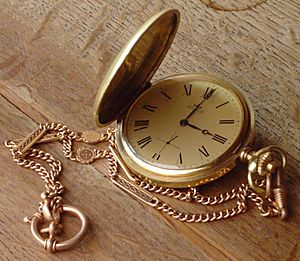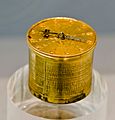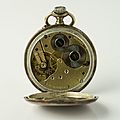Pocket watch facts for kids
A pocket watch is a small timepiece that you carry in your pocket, unlike a wristwatch that you wear on your wrist. It's believed that a German craftsman named Peter Henlein invented the first pocket watch.
Pocket watches usually have a chain attached to them. This chain connects the watch to your clothing, like a vest or jacket. This way, the watch won't accidentally fall out of your pocket and get damaged. These watches were very popular for a long time, especially before wristwatches became common. Today, wristwatches are much more popular, but some people still enjoy wearing pocket watches. A golden pocket watch is sometimes given as a special gift when someone retires from their job.
Contents
The Story of Pocket Watches
Pocket watches have a long and interesting history. They were among the first personal time-telling devices that people could carry around.
Early Beginnings
The very first portable clocks were made in the early 1500s. They were quite large and heavy, often worn around the neck on a chain. These early versions were sometimes called clock-watches or Nuremberg eggs, named after the German city where they were made. Peter Henlein, from Nuremberg, is often credited with making some of the earliest portable clocks.
From Neck to Pocket
Over time, these clock-watches became smaller and flatter. By the late 1600s, they were thin enough to be carried in a pocket, which is how they got their name. This was a big step forward because it made telling time much more convenient for people on the go.
How They Work
Most pocket watches work using a mechanical movement. Inside, there are many tiny gears, springs, and levers that work together to keep track of time.
The Mainspring and Balance Wheel
- The mainspring is like the engine of the watch. When you wind the watch, you tighten this spring, storing energy.
- This energy is then slowly released to power the gears.
- A balance wheel swings back and forth, controlling how fast the gears move. It's like the pendulum in a grandfather clock, but much smaller.
- This careful movement of parts makes the hands on the watch face move at the correct speed, showing you the time.
Types of Pocket Watches
There are a few main styles of pocket watches you might see:
- Open-face: These watches have no cover over the crystal (the clear part that protects the dial). You can see the time instantly.
- Hunter-case (or Savonette): These watches have a hinged metal cover that protects the crystal. You press a button to open the cover and see the time. This style was popular for protecting the watch face from scratches.
- Half-hunter: These have a cover with a small hole or crystal in the center, allowing you to see the time without fully opening the cover.
Why Wristwatches Took Over
For centuries, the pocket watch was the main way people carried time with them. But things started to change in the early 1900s.
- World War I: During the war, soldiers found it difficult to pull a watch out of their pocket while fighting. Wearing a watch on the wrist was much more practical and quicker to check.
- Convenience: After the war, people realized that wristwatches were simply more convenient for everyday life. They were easier to glance at while driving, working, or doing sports.
- Fashion: As wristwatches became more popular, they also became a new fashion statement.
Because of these reasons, wristwatches quickly became the most common type of watch, and pocket watches became less popular for daily use.
Pocket Watches Today
Even though wristwatches are everywhere, pocket watches haven't completely disappeared.
- Collectors: Many people collect antique pocket watches because of their beautiful craftsmanship and historical value.
- Special Occasions: Some people wear pocket watches for formal events, like weddings, or as a unique fashion accessory.
- Gifts: As mentioned, a gold pocket watch can still be a meaningful gift, especially for retirement or other big milestones.
They are a reminder of a time when telling time was a more deliberate and elegant act.
Images for kids
-
Pocketwatches evolved from clock-watches, supposedly called Nuremberg eggs, worn on chains around the neck. Example by Peter Henlein, 1510, Germanisches Nationalmuseum Nuremberg.
-
A so-called "mystery watch" with a transparent dial, c. 1889, Musée d'Horlogerie of Le Locle, Switzerland. It is the first transparent watch.
-
The c. 1950 Omega pocket watch is of stem-wind, stem-set movement.
-
An 'Hebdomas' 8 day pocket watch, circa 1920, Musée d'Horlogerie of Le Locle, Switzerland. Patented in 1889, discontinued a number of years and reintroduced in 1968 is still manufactured. An example of the decline and resurgence of the pocket watch.
See also
 In Spanish: Reloj de bolsillo para niños
In Spanish: Reloj de bolsillo para niños
















